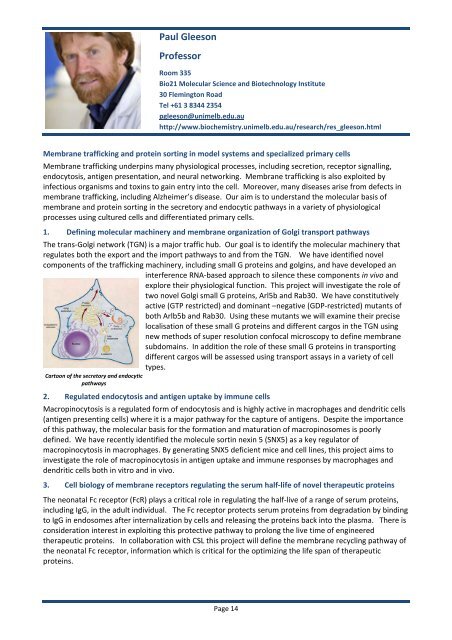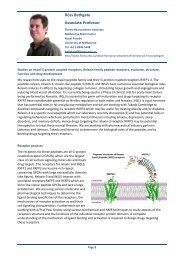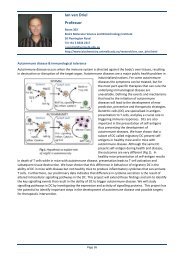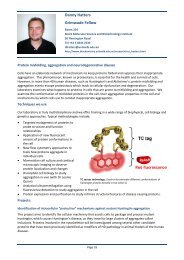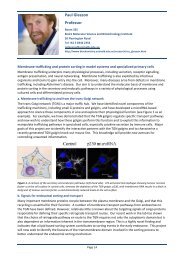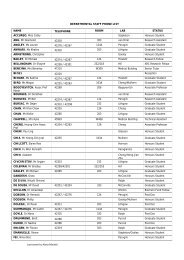Paul Gleeson Professor - Department of Biochemistry and Molecular ...
Paul Gleeson Professor - Department of Biochemistry and Molecular ...
Paul Gleeson Professor - Department of Biochemistry and Molecular ...
You also want an ePaper? Increase the reach of your titles
YUMPU automatically turns print PDFs into web optimized ePapers that Google loves.
<strong>Paul</strong> <strong>Gleeson</strong><strong>Pr<strong>of</strong>essor</strong>Room 335Bio21 <strong>Molecular</strong> Science <strong>and</strong> Biotechnology Institute30 Flemington RoadTel +61 3 8344 2354pgleeson@unimelb.edu.auhttp://www.biochemistry.unimelb.edu.au/research/res_gleeson.htmlMembrane trafficking <strong>and</strong> protein sorting in model systems <strong>and</strong> specialized primary cellsMembrane trafficking underpins many physiological processes, including secretion, receptor signalling,endocytosis, antigen presentation, <strong>and</strong> neural networking. Membrane trafficking is also exploited byinfectious organisms <strong>and</strong> toxins to gain entry into the cell. Moreover, many diseases arise from defects inmembrane trafficking, including Alzheimer’s disease. Our aim is to underst<strong>and</strong> the molecular basis <strong>of</strong>membrane <strong>and</strong> protein sorting in the secretory <strong>and</strong> endocytic pathways in a variety <strong>of</strong> physiologicalprocesses using cultured cells <strong>and</strong> differentiated primary cells.1. Defining molecular machinery <strong>and</strong> membrane organization <strong>of</strong> Golgi transport pathwaysThe trans‐Golgi network (TGN) is a major traffic hub. Our goal is to identify the molecular machinery thatregulates both the export <strong>and</strong> the import pathways to <strong>and</strong> from the TGN. We have identified novelcomponents <strong>of</strong> the trafficking machinery, including small G proteins <strong>and</strong> golgins, <strong>and</strong> have developed aninterference RNA‐based approach to silence these components in vivo <strong>and</strong>explore their physiological function. This project will investigate the role <strong>of</strong>two novel Golgi small G proteins, Arl5b <strong>and</strong> Rab30. We have constitutivelyactive (GTP restricted) <strong>and</strong> dominant –negative (GDP‐restricted) mutants <strong>of</strong>both Arlb5b <strong>and</strong> Rab30. Using these mutants we will examine their preciselocalisation <strong>of</strong> these small G proteins <strong>and</strong> different cargos in the TGN usingnew methods <strong>of</strong> super resolution confocal microscopy to define membranesubdomains. In addition the role <strong>of</strong> these small G proteins in transportingdifferent cargos will be assessed using transport assays in a variety <strong>of</strong> celltypes.Cartoon <strong>of</strong> the secretory <strong>and</strong> endocyticpathways2. Regulated endocytosis <strong>and</strong> antigen uptake by immune cellsMacropinocytosis is a regulated form <strong>of</strong> endocytosis <strong>and</strong> is highly active in macrophages <strong>and</strong> dendritic cells(antigen presenting cells) where it is a major pathway for the capture <strong>of</strong> antigens. Despite the importance<strong>of</strong> this pathway, the molecular basis for the formation <strong>and</strong> maturation <strong>of</strong> macropinosomes is poorlydefined. We have recently identified the molecule sortin nexin 5 (SNX5) as a key regulator <strong>of</strong>macropinocytosis in macrophages. By generating SNX5 deficient mice <strong>and</strong> cell lines, this project aims toinvestigate the role <strong>of</strong> macropinocytosis in antigen uptake <strong>and</strong> immune responses by macrophages <strong>and</strong>dendritic cells both in vitro <strong>and</strong> in vivo.3. Cell biology <strong>of</strong> membrane receptors regulating the serum half‐life <strong>of</strong> novel therapeutic proteinsThe neonatal Fc receptor (FcR) plays a critical role in regulating the half‐live <strong>of</strong> a range <strong>of</strong> serum proteins,including IgG, in the adult individual. The Fc receptor protects serum proteins from degradation by bindingto IgG in endosomes after internalization by cells <strong>and</strong> releasing the proteins back into the plasma. There isconsideration interest in exploiting this protective pathway to prolong the live time <strong>of</strong> engineeredtherapeutic proteins. In collaboration with CSL this project will define the membrane recycling pathway <strong>of</strong>the neonatal Fc receptor, information which is critical for the optimizing the life span <strong>of</strong> therapeuticproteins.Page 14
HeLa cell expressing a epitope taggedmembraneprotein, mutated in a Tyrbasedinternalization motif, resultingin the accumulation <strong>of</strong> the membraneprotein (red) on the cell surface <strong>of</strong>transfected cells. 3D reconstruction <strong>of</strong>confocal images showing membraneprotein (red), Golgi marker (green) <strong>and</strong>nuclear DAPI staining (blue).4. Signals for endosomal sorting in development <strong>and</strong> diseaseA number <strong>of</strong> important membrane proteins recycle between the plasmamembrane <strong>and</strong> the Golgi, <strong>and</strong> this recycling is essential for their function.Perturbation <strong>of</strong> these pathways can result in diseases, including neurodegenerativediseases such as Alzheimer’s disease. Very little is known about the targetingsignals <strong>of</strong> cargo proteins that define this transport pathway. This project willdefine these targeting signals by the generation <strong>and</strong> analysis <strong>of</strong> mutants <strong>of</strong>membrane cargos using defined transport assays <strong>and</strong> by the silencing pathwayspecifictrafficking machinery.References/publications/recommended reading1. Kerr M.C., Lindsay M.R. Luetterforst R., Hamilton N., Simpson F., Parton R.G., <strong>Gleeson</strong> P.A., TeasdaleR.D. (2006). Visualisation <strong>of</strong> macropinosome maturation by the recruitment <strong>of</strong> sorting nexins. J. Cell Sci.119:3967‐80.2. Lieu, Z.Z., Lock, J.G., Hammond, L.A., La Gruta, N. L, Stow, J. L. <strong>and</strong> <strong>Gleeson</strong>, P.A. (2008). A trans‐Golginetwork golgin is required for the regulated secretion <strong>of</strong> TNFa in activated macrophages in vivo. Proc. Natl.Acad. Sci USA, 105:3351‐63. Houghton F, Chew PL, Lohedo S, Goud B <strong>and</strong> <strong>Gleeson</strong> PA (2009) The localization <strong>of</strong> the golgin, GCC185,is independent <strong>of</strong> Rab6 <strong>and</strong> Arl1. Cell 138: 787‐7944. <strong>Gleeson</strong> PA <strong>and</strong> Goud, B (2010) TGN golgins, Rabs <strong>and</strong> cytoskeleton: Regulating the Golgi trafficking highways. Trends Cell Biol 20(6):329‐36.5. Phey Lim, J. <strong>and</strong> <strong>Gleeson</strong>, P.A. (2011). Macropinocytosis: An endocytic pathway for internalising large gulps. Immunol Cell Biol 89:836‐8436. Chia, PZC, Gasnereau, I, Lieu, ZZ <strong>and</strong> <strong>Gleeson</strong>, PA (2011). Rab‐9 dependent retrograde transport <strong>and</strong> endosomal sorting <strong>of</strong> the endopeptidase,furin. J. Cell Sci. 124:2401‐2413Autoimmunity <strong>and</strong> molecular immunology –Collaborators <strong>Pr<strong>of</strong>essor</strong> Ian van Driel <strong>and</strong> Dr Dorothee Bourges,<strong>Department</strong> <strong>of</strong> <strong>Biochemistry</strong> <strong>and</strong> <strong>Molecular</strong> BiologyFailure <strong>of</strong> immunological self‐tolerance <strong>of</strong>ten leads to the development <strong>of</strong> autoimmune diseases, whichafflict up to 5% <strong>of</strong> the population. The underlying causes <strong>of</strong> autoimmune diseases are still unknown,although infections are strong c<strong>and</strong>idates for initiating autoimmunity by promoting the maturation <strong>of</strong>dendritic cells (DCs) that present tissue self‐antigens. Research in the van Driel/<strong>Gleeson</strong> laboratory focuseson defining how autoimmune disease develops, with a particular emphasis on the role <strong>of</strong> dendritic cells <strong>and</strong>regulatory T cells. The lab works on a murine model <strong>of</strong> autoimmune gastritis, a highly define system inwhich the target autoantigen is naturally expressed in the stomach.This project will analyse the relationship between inflammatory stimuli, the maturation status <strong>of</strong> DCs thatpresent gastric self‐epitopes <strong>and</strong> the development <strong>of</strong> organ‐specific autoimmunity.We have established an experimental autoimmune disease <strong>of</strong> the stomach(autoimmune gastritis) as a powerful model <strong>of</strong> organ‐specific autoimmunity<strong>and</strong> have identified the gastric autoantigens that are recognized by the selfreactiveeffector T cells. CD4 + T cells that mediate the disease recognize thehighly abundant gastric H/K ATPase heterodimer. Immune tolerance to thesegastric self‐antigens occurs primarily in the periphery. Most importantly, wehave also identified a subpopulation <strong>of</strong> migratory DCs in the draining lymphnode <strong>of</strong> the stomach that presents the endogenous gastric H/K ATPaseantigen. Hence, we are now able to compare the status <strong>of</strong> DCs whichpresent the gastric antigen, from normal mice <strong>and</strong> mice with autoimmunegastritis, as a basis for underst<strong>and</strong>ing the shift from tolerance toautoimmunity. This project will involve the isolation <strong>of</strong> the migratorypopulation <strong>of</strong> DCs by st<strong>and</strong>ards methods in the lab, analysis <strong>of</strong> TLR expression <strong>of</strong> these migratory DCs <strong>and</strong>assessment <strong>of</strong> the impact <strong>of</strong> different TLR lig<strong>and</strong>s on the maturation <strong>and</strong> functional status <strong>of</strong> these DCs byanalysis <strong>of</strong> cytokine pr<strong>of</strong>iles <strong>and</strong> activation <strong>of</strong> gastric‐specific effector T cell responses.Figure 2 Gastric cells express anautoantigen which is presented in thelocal draining lymph nodes by migratorydendritic cellReferences/publications/recommended reading.1. Read S, Hogan, T, Zwar, T, <strong>Gleeson</strong>, PA <strong>and</strong> van Driel, IR (2007). Prevention <strong>of</strong> autoimmune gastritis in mice requires extra‐thymic deletion<strong>and</strong> regulation <strong>of</strong> CD4+CD25+ T cells. Gastroenterology 133: 547‐552. Kim JM, Rasmussen, JP <strong>and</strong> Rudensky, AY. (2007) regulatory T cells prevent catastrophic autoimmunity throughout the lifespan <strong>of</strong> mice. NatImmunol 8, 191‐197.3. Allen, S, Turner, SJ, Bourges, D, <strong>Gleeson</strong>, PA <strong>and</strong> van Driel, IR (2011). Shaping the T‐cell repertoire in the periphery. Immunol Cell Biol. 89 : 60‐69 (IF 4.2)Page 15


